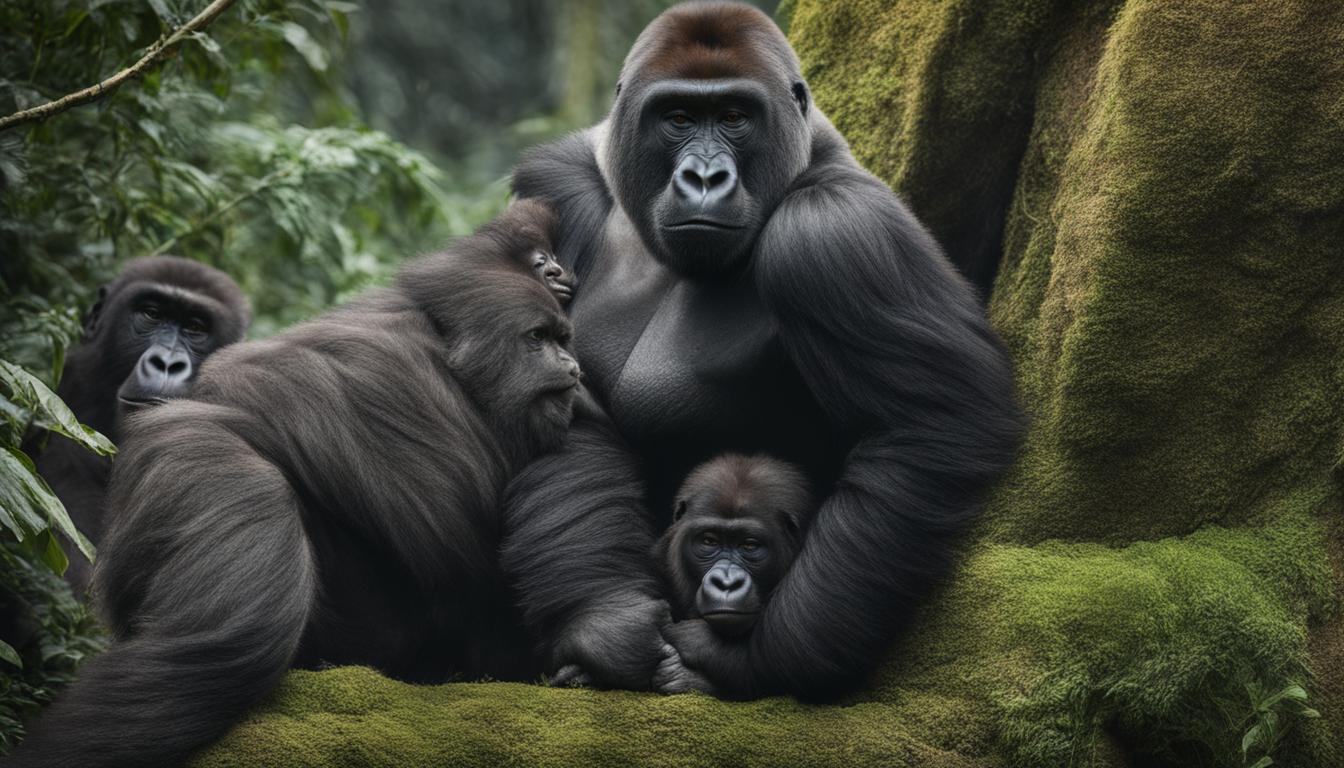Gorillas are fascinating creatures that belong to the Gorilla gorilla species. There are different species of gorillas, each with its own distinct characteristics and features. Understanding these distinctions is essential in appreciating and conserving these incredible animals.
The Gorilla gorilla species is composed of two main species: the eastern gorilla and the western gorilla. These species are further divided into different subspecies, each with its own unique traits and habitats.
In this article, we will explore the different species of gorillas, their distinctions, and the importance of conservation efforts to protect these magnificent creatures.
Eastern Gorilla Species
The Eastern gorilla species is composed of two subspecies: the Mountain gorilla and the Eastern Lowland gorilla. These gorillas have unique habitats and behaviors that set them apart from other gorilla species.
Mountain Gorilla
The Mountain gorilla is known for its habitat in the Virunga Mountains, spanning the Democratic Republic of Congo, Rwanda, and Uganda. These gorillas live in forests at high elevations, ranging from 8,000 to 13,000 feet. To survive in the colder temperatures of their habitat, Mountain gorillas have developed thick fur that helps keep them warm. Despite their adaptation to the challenging conditions, the Mountain gorilla population is critically endangered, with around 1,000 individuals remaining in the wild.
Eastern Lowland Gorilla
The Eastern Lowland gorilla, also referred to as the Grauer’s gorilla, resides in the tropical rainforests of the Democratic Republic of Congo. These gorillas face numerous threats, including habitat destruction and poaching. Their population has declined by more than 50% in the past 50 years, leading to their classification as critically endangered. Efforts are being made to protect and conserve the remaining Eastern Lowland gorillas, as they play a vital role in the ecosystem.
Both subspecies of the Eastern gorilla species are critically endangered due to habitat loss and poaching. Conservation initiatives and research play a crucial role in understanding and protecting these magnificent creatures, as well as their habitats. By supporting these efforts, we can help ensure a future for the Eastern gorilla species.
| Gorilla Species | Scientific Name | Habitat | Population |
|---|---|---|---|
| Mountain gorilla | Gorilla beringei beringei | Virunga Mountains | Approximately 1,000 |
| Eastern Lowland gorilla | Gorilla beringei graueri | Tropical rainforests of the Democratic Republic of Congo | Declined by more than 50% in the past 50 years |
Western Gorilla Species
The Western gorilla species consists of two subspecies: the Cross River gorilla and the Western Lowland gorilla. These gorillas are primarily found in the tropical forests of Central Africa.
The Cross River gorilla is one of the rarest gorilla subspecies, with a population of only 200-300 individuals. They inhabit a small area in the border region between Cameroon and Nigeria, encompassing approximately 3,000 square miles.
The Western Lowland gorilla, on the other hand, is the most abundant subspecies of gorilla. They are distributed across a larger range, spanning from Cameroon to the Republic of Congo. However, their population has declined by more than 60% in the past 20-25 years due to habitat loss and poaching.
Conservation efforts play a crucial role in protecting these Western gorilla subspecies. By preserving their habitats, implementing anti-poaching measures, and raising awareness about the importance of gorilla conservation, we can ensure the survival of these magnificent creatures and maintain the biodiversity of our planet.
| Western Gorilla Subspecies | Population | Conservation Status |
|---|---|---|
| Cross River gorilla | 200-300 | Critically Endangered |
| Western Lowland gorilla | Unknown (declined by over 60% in the past 20-25 years) | Endangered |
Gorilla Behavior and Habitat
Gorillas are fascinating creatures with unique behaviors and specific habitats. Understanding their behavior and habitat is crucial for their conservation and protection. Here, we delve into the intriguing world of gorilla behavior, their preferred habitats, and the challenges they face in maintaining their populations.
Gorilla Behavior
Gorillas exhibit complex social structures and behaviors. They live in family groups led by a dominant silverback male, who protects and leads the group. Gorillas are highly intelligent and communicate using a variety of vocalizations and body gestures. They form tight-knit bonds within their family units and engage in grooming behaviors to strengthen social bonds.
Gorillas are primarily herbivorous, feeding on a variety of vegetation in their habitats. Their diet consists of tree shoots, leaves, vines, and branches. They are known to have a slow reproductive rate, with females giving birth to only one offspring at a time, usually every four to six years. This slow reproductive rate makes them particularly vulnerable to population declines.
Gorilla Habitat
Gorillas inhabit the tropical forests of equatorial Africa. They can be found in various countries, including the Democratic Republic of Congo, Rwanda, Uganda, Cameroon, and Nigeria. These forests provide them with a rich and diverse habitat, filled with the necessary resources for their survival.
Gorillas are primarily found in montane and lowland rainforests. Mountain gorillas, a subspecies of the eastern gorilla, inhabit forests at high elevations, ranging from 8,000 to 13,000 feet. They are adapted to colder temperatures and have thick fur to withstand the harsh climatic conditions of their habitat.
The lowland gorillas, both eastern and western subspecies, reside in tropical rainforests. These forests are lush and dense, providing ample food and shelter for gorillas. However, the increasing human population and deforestation pose significant threats to their habitat.
| Species | Common Name | Habitat |
|---|---|---|
| Gorilla beringei | Mountain Gorilla | Montane forests at high elevations |
| Gorilla beringei | Eastern Lowland Gorilla | Tropical rainforests of the Democratic Republic of Congo |
| Gorilla gorilla | Western Lowland Gorilla | Tropical rainforests across the region from Cameroon to the Republic of Congo |
Gorillas face numerous challenges to their survival, including habitat loss, poaching, and diseases like Ebola. Conservation efforts focused on protecting their habitats, combating illegal wildlife trade, and raising awareness about their importance are vital for the continued existence of these incredible animals.
By understanding and respecting gorilla behavior and their habitat needs, we can work towards ensuring a future where gorillas thrive in their natural habitats. Join the cause and support gorilla conservation initiatives to protect these majestic creatures and the ecosystems they call home.
Gorilla Population and Conservation
Gorillas are classified as endangered species according to the IUCN Red List, with all subspecies of gorillas being either critically endangered or endangered. The overall population of gorillas has declined due to various factors such as habitat destruction, poaching, and diseases. Western gorillas have an estimated population of around 316,000 individuals, while eastern gorillas have a population of approximately 5,000 individuals.
Conservation efforts have been crucial in stabilizing and increasing gorilla populations in some areas. Protected areas and anti-poaching measures have played a significant role in protecting their habitats and reducing illegal activities. Additionally, research and monitoring programs have provided valuable insights into gorilla behavior, population dynamics, and threats they face.
“Conservation is not only about protecting gorillas, but also about preserving the ecosystems they inhabit. Gorillas are keystone species, playing a vital role in maintaining the balance of their forest habitats. By conserving gorillas, we are conserving the biodiversity of these ecosystems.”
Gorilla conservation initiatives often involve collaboration between local communities, governments, and international organizations. These efforts aim to raise awareness, implement sustainable practices, and provide alternative livelihoods to communities living near gorilla habitats. Continuous monitoring and evaluation of conservation programs are essential to adapt strategies and ensure their effectiveness.
Table: Comparison of Gorilla Populations
| Gorilla Species | Estimated Population |
|---|---|
| Western Gorillas | Approximately 316,000 individuals |
| Eastern Gorillas | Approximately 5,000 individuals |

The conservation of gorillas is an ongoing effort that requires continued support and collaboration from individuals, organizations, and governments. By recognizing the importance of gorillas in maintaining healthy ecosystems and taking action to protect them, we can contribute to their survival and the preservation of biodiversity.
Conclusion
Gorillas are incredible creatures that belong to different species and subspecies, each with its own unique characteristics and habitats. The eastern gorilla species, consisting of the Mountain gorilla and the Eastern Lowland gorilla, and the western gorilla species, comprising the Cross River gorilla and the Western Lowland gorilla, showcase the rich diversity within the gorilla family.
Unfortunately, all species and subspecies of gorillas are currently endangered. Their populations face significant threats due to habitat destruction and poaching. Conservation efforts play a crucial role in the survival and protection of these magnificent animals and their habitats.
By raising awareness and supporting gorilla conservation initiatives, we can contribute to the preservation of these incredible creatures and their important role in maintaining biodiversity. Together, we can make a difference in safeguarding the Gorilla gorilla species, ensuring their populations thrive for generations to come.
How do the distinctions between different species of chimpanzees compare to those of different species of gorillas?
When comparing the distinctions between different species of chimpanzees to those of different species of gorillas, it is evident that both groups exhibit unique social behaviors, diet preferences, and physical characteristics. However, chimpanzees tend to be more socially complex, while gorillas are typically larger and more herbivorous.
FAQ
What are the different species of gorillas and their distinctions?
There are two species of gorillas in the world: the eastern gorilla and the western gorilla. The eastern gorilla species consists of the Mountain gorilla and the Eastern Lowland gorilla. The western gorilla species consists of the Cross River gorilla and the Western Lowland gorilla. The main distinctions between these species are the size of their noses and the sounds they make when communicating. The eastern gorilla is generally larger than the western gorilla.
Where do the Eastern gorilla species live and what are their populations?
The Eastern gorilla species is composed of two subspecies: the Mountain gorilla and the Eastern Lowland gorilla. Mountain gorillas live in forests at high elevations, ranging from 8,000 to 13,000 feet. They inhabit the Virunga Mountains, which span the Democratic Republic of Congo, Rwanda, and Uganda. Eastern Lowland gorillas reside in the tropical rainforests of the Democratic Republic of Congo. Their population has declined by more than 50% in the past 50 years. Both subspecies are critically endangered and face threats from habitat loss and poaching.
Where do the Western gorilla species live and what are their populations?
The Western gorilla species is divided into two subspecies: the Cross River gorilla and the Western Lowland gorilla. Cross River gorillas are found in the forests of Cameroon and Nigeria, within an area of about 3,000 square miles. They are critically endangered, with a population of only 200-300 individuals. The Western Lowland gorilla is the most abundant subspecies, found across the region from Cameroon to the Republic of Congo. Their exact population is unknown, but it has decreased by more than 60% in the past 20-25 years. Both subspecies are at risk due to poaching and habitat destruction.
What are gorillas’ diet and social structure?
Gorillas are herbivorous primates that primarily inhabit the tropical forests of equatorial Africa. They have a complex social structure, living in family groups led by a dominant silverback male. Gorillas are nomadic in nature, constantly moving within their habitats in search of food. They primarily feed on tree shoots, leaves, vines, and branches.
Why are gorillas endangered and what are the conservation efforts?
Gorillas are classified as endangered species according to the IUCN Red List, with all subspecies of gorillas being either critically endangered or endangered. The overall population of gorillas has declined due to various factors such as habitat destruction, poaching, and diseases. Conservation efforts, including protected areas and anti-poaching measures, have been successful in stabilizing and increasing gorilla populations in some areas. However, continued efforts are crucial for the survival and protection of these magnificent animals and their habitats.










